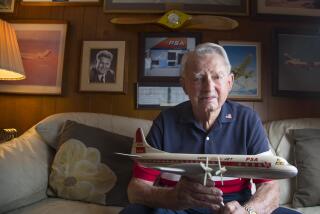British-Built PSA Aircraft Known for ‘Good Track Record’
- Share via
National Transportation Safety Board officials said Monday that the BAe-146 aircraft has a “good track record” and is known for being an “economical, good-handling plane.”
But the model, first put into service in 1984, did encounter at least one major engine problem on a February PSA flight from Los Angeles to Reno.
In that incident, one engine on a BAe-146 failed and forced an emergency landing in Fresno.
There were no injuries, but one chunk of the engine pierced the cabin at 25,000 feet and came to rest in an overhead bin, causing a drop in cabin pressure. Another piece of the engine was found smoldering in the baggage area and a third chunk cracked a window.
“This was an uncontained engine failure that could have resulted in major damage,” Gary Mucho, chief of the safety board’s Los Angeles office that investigated the incident, said at the time. “It had a potential to start a major fire, since hot metal parts could have pierced the fuel tank.”
First to Use Them
PSA became the first airline to put the BAe-146 into service when it agreed to buy 20 of the aircraft for $300 million. The loss-plagued San Diego-based airline was betting that the BAe-146, with its quiet operation, would enable PSA to dominate California’s noise-sensitive airports such as John Wayne Airport and Burbank.
The British Aerospace-built plane was known for being super-quiet and fuel-efficient.
The PSA move forced its biggest competitor--AirCal--to buy six of the same aircraft, which now is rapidly becoming the workhorse of the Los Angeles-San Francisco corridor, one of the most heavily traveled and competitive air routes in the world.
Still Largest Owner
PSA, with 24 of the unusual-looking 100-seat jets, is still the largest owner of BAe-146s, but 13 other airlines, from CASC of China to Air Wisconsin, also now own the four-engine planes.
Allan Pollock, a spokesman with the safety board, said he was with the now-defunct Civil Aeronautics Board in the early 1980s when the BAe-146 was being certified and remembers it getting “high marks . . . with an obvious ability to fly into airports with noise restrictions.”
Aviation Week and Space Technology magazine put the aircraft through its paces for a 1983 article and concluded that the plane reduced cockpit workload, had an ability to fly steep approach angles and had a good braking ability.
“Visibility from the cockpit is excellent,” the article reported. “We were operating . . . on a hazy day with several light aircraft in the area, including one that did not respond to (the control) tower’s radio calls. Cockpit visibility enabled us to keep the other aircraft, as well as the runway threshold, in sight.”
Report Unavailable
A complete safety record from the safety board was not immediately available Monday.
The engines used on the BAe-146 are made by Connecticut-based Avco Lycoming. They do not have a long track record in commercial aviation.
The engines, used to power combat helicopters during the Vietnam War, had not been used in a commercial aviation before 1984.
“There was some (internal) resistance” to buying the planes, Byron Miller, PSA vice president of market planning, recalled in a 1985 interview with The Times. That decision, he said, was “a hell of a gamble.”
Initially, some PSA officials were reluctant to make such a large commitment to the plane.
“We had our eyes open, though,” Miller said. “We knew that (if the strategy worked) we’d end up being the big frog in the pond.”
Not only is the aircraft much quieter than planes of similar size, but its design allows for efficient takeoffs and landings--allowing PSA to run frequent short-run flights among West Coast cities, according to its maker.
Besides buying 20 planes in its initial order in 1983, PSA took an option on an additional 25.
The British Aerospace 146 In 1973, Hawker Siddeley announced plans to produce--with British government support--a quiet-operating transport aircraft.
Hawker Siddeley was absorbed by British Aircraft Corp. in 1977; the decision to go ahead with the 146 series came in 1978.
Three series of the unusual-shaped aircraft eventually were produced.
The BAe 146 is powered by four turbofan engines mounted from underside of the wings.
AirCal has ordered six of the aircraft; PSA has ordered 24. The first planes were delivered in 1986.
Seating capacity: Between 82 and 109.
Wings: Cantilever high-wing structure with a span of 86 feet, 5 inches.
Tail: Sweptback “T” tail
Speed: Slower than other jet aircraft, the BAe 146’s attraction is its relatively quiet operation.
More to Read
Inside the business of entertainment
The Wide Shot brings you news, analysis and insights on everything from streaming wars to production — and what it all means for the future.
You may occasionally receive promotional content from the Los Angeles Times.










